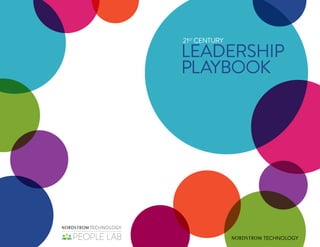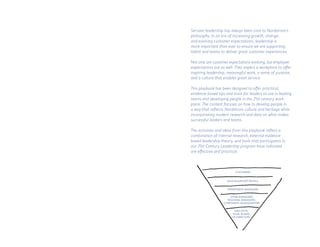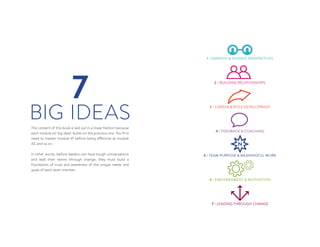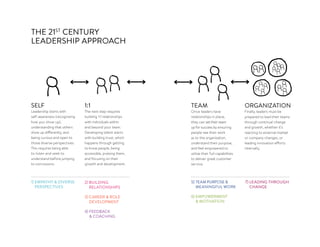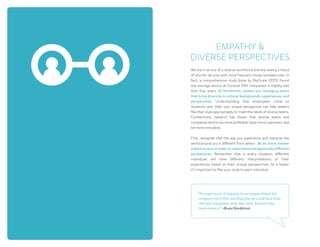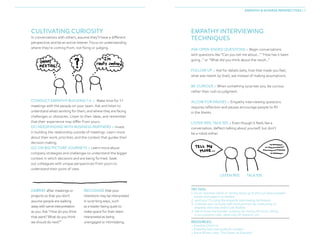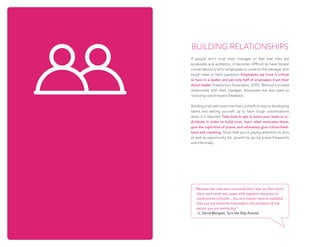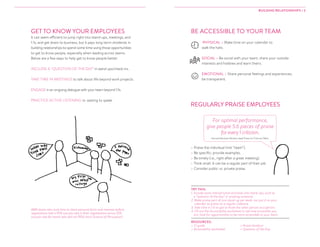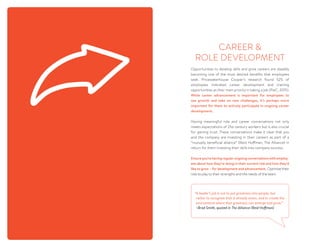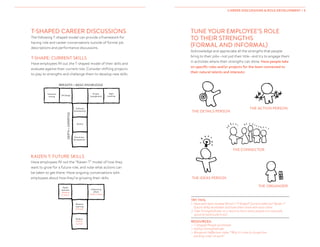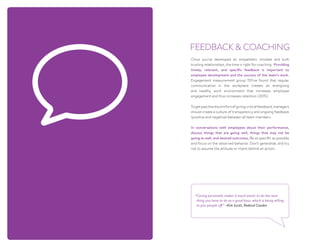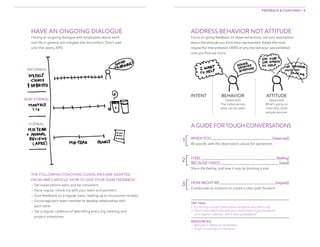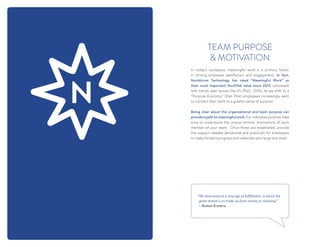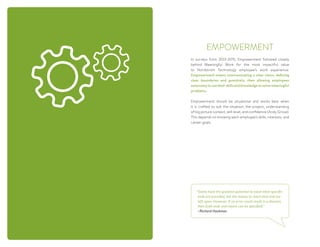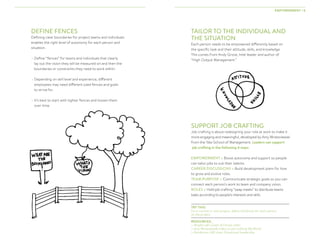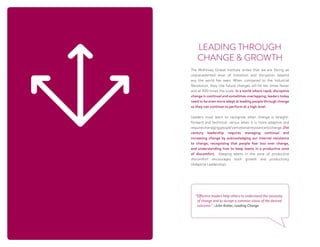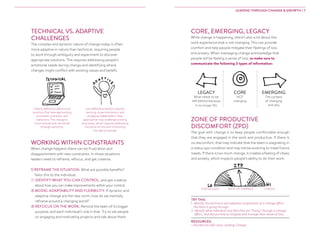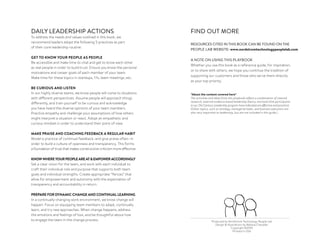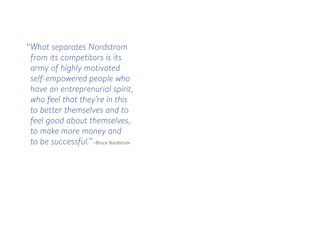21st Century leadership Playbook
- 2. Servant leadership has always been core to Nordstrom’s philosophy. In an era of increasing growth, change, and evolving customer expectations, leadership is more important than ever to ensure we are supporting talent and teams to deliver great customer experiences. Not only are customer expectations evolving, but employee expectations are as well. They expect a workplace to offer inspiring leadership, meaningful work, a sense of purpose, and a culture that enables great service. This playbook has been designed to offer practical, evidence-based tips and tools for leaders to use in leading teams and developing people in the 21st century work- place. The content focuses on how to develop people in a way that reflects Nordstrom culture and heritage while incorporating modern research and data on what makes successful leaders and teams. The activities and ideas from this playbook reflect a combination of internal research, external evidence- based leadership theory, and tools that participants in our 21st Century Leadership program have indicated are effective and practical. CUSTOMERS SALES & SUPPORT PEOPLE DEPARTMENT MANAGERS STORE MANAGERS, REGIONAL MANAGERS, CORPORATE HEADQUARTERS EXECUTIVE TEAM, BOARD OF DIRECTORS
- 3. 7 BIG IDEAS 1 / EMPATHY & DIVERSE PERSPECTIVES 2 / BUILDING RELATIONSHIPS 3 / CAREER & ROLE DEVELOPMENT 4 / FEEDBACK & COACHING 5 / TEAM PURPOSE & MEANINGFUL WORK 6 / EMPOWERMENT & MOTIVATION 7 / LEADING THROUGH CHANGE The content of this book is laid out in a linear fashion because each module (or big idea) builds on the previous one. You first need to master module #1 before being effective at module #2, and so on. In other words, before leaders can have tough conversations and lead their teams through change, they must build a foundation of trust and awareness of the unique needs and goals of each team member.
- 4. SELF Leadership starts with self-awareness (recognizing how you show up), understanding that others show up differently, and being curious and open to those diverse perspectives. This requires being able to listen and seek to understand before jumping to conclusions. THE 21ST CENTURY LEADERSHIP APPROACH 1:1 The next step requires building 1:1 relationships with individuals within and beyond your team. Developing talent starts with building trust, which happens through getting to know people, being accessible, praising them, and focusing on their growth and development. TEAM Once leaders have relationships in place, they can set their team up for success by ensuring people see their work as to the organization, understand their purpose, and feel empowered to utilize their full capabilities to deliver great customer service. ORGANIZATION Finally, leaders must be prepared to lead their teams through continual change and growth, whether it’s reacting to external market or company changes, or leading innovation efforts internally. 1) EMPATHY DIVERSE PERSPECTIVES 2) BUILDING RELATIONSHIPS 3) CAREER ROLE DEVELOPMENT 4) FEEDBACK COACHING 5) TEAM PURPOSE MEANINGFUL WORK 6) EMPOWERMENT MOTIVATION 7) LEADING THROUGH CHANGE
- 5. We are in an era of a diverse workforce and are seeing a trend of shorter tenures with more frequent moves between jobs. In fact, a comprehensive study done by PayScale (2015) found the average tenure at Fortune 500 companies is slightly less than four years. At Nordstrom, leaders are managing teams that bring diversity in cultural backgrounds, experiences, and perspectives. Understanding that employees come to situations with their own unique perspective can help leaders flex their style appropriately to meet the needs of diverse teams. Furthermore, research has shown that diverse teams and companies tend to be more profitable, have more customers, and be more innovative. First, recognize that the way you experience and interpret the world around you is different from others. Be an active listener and be curious in order to understand and appreciate different perspectives. Remember that in every situation, different individuals will have different interpretations of their experiences based on their unique perspectives. As a leader it’s important to flex your style to each individual. EMPATHY DIVERSE PERSPECTIVES “The experience of listening to our people helped this company more than anything else we could have done. Ask your top people what they need, because they have answers.” ~Bruce Nordstrom
- 6. CULTIVATING CURIOSITY In conversations with others, assume they’ll have a different perspective, and be an active listener. Focus on understanding where they’re coming from, not fixing or judging. CONDUCT EMPATHY BUILDING 1:1s Make time for 1:1 meetings with the people on your team. Ask and listen to understand whats working for them, and where they are facing challenges or obstacles. Listen to their ideas, and remember that their experience may differ from yours. DO NEEDFINDING WITH BUSINESS PARTNERS Invest in building the relationship outside of meetings. Learn more about their work, priorities, and the context that guides their decision making. GO ON BIG PICTURE JOURNEYS Learn more about company strategies and challenges to understand the bigger context in which decisions and are being formed. Seek out colleagues with unique perspectives from yours to understand their point of view. EMPATHY INTERVIEWING TECHNIQUES ASK OPEN-ENDED QUESTIONS Begin conversations with questions like “Can you tell me about...” “How has it been going...” or “What did you think about the result...” FOLLOW UP Ask for details (why, how that made you feel, what was meant by that); ask instead of making assumptions. BE CURIOUS When something surprises you, be curious rather than rush to judgment. ALLOW FOR PAUSES Empathy interviewing questions requires reflection and pauses encourage people to fill in the blanks. LISTEN 90%, TALK 10% Even though it feels like a conversation, deflect talking about yourself, but don’t be a robot either. DEBRIEF after meetings or projects so that you don’t assume people are walking away with same interpretation as you. Ask “How do you think that went? What do you think we should do next?” RECOGNIZE that your intentions may be interpreted in surprising ways, such as a leader being quiet to make space for their team interpreted as being unengaged or intimidating. EMPATHY DIVERSE PERSPECTIVES / 1 RESOURCES: Emotion Check-In Empathy Interview guide for Leaders Brene Brown video “The Power of Empathy” TRY THIS: 1. Do an “emotion check-in” during stand-up to find out about people’s moods and support as needed. 2. Lead your 1:1s using the empathy interviewing techniques. 3. Cultivate your curiosity with work partners by conducting an empathy interview and/or job shadow. 4. Get to know the broader company by visiting the store, sitting in on customer calls, observing UX research, etc. LISTEN 90% TALK 10%
- 7. BUILDING RELATIONSHIPS If people don’t trust their manager or feel that they are accessible and authentic, it becomes difficult to have honest conversations and for employees to come to the manager with tough news or hard questions. Employees say trust is critical to have in a leader, and yet only half of employees trust their direct leader (Interaction Associates, 2015). Without a trusted relationship with their manager, employees are less open to receiving coaching and feedback. Building trust with team members is the first step to developing talent and setting yourself up to have tough conversations when it is required. Take time to get to know your team as in- dividuals in order to build trust, learn what motivates them, give the right kind of praise, and ultimately give critical feed- back and coaching. Show that you’re paying attention to wins as well as opportunity for growth by giving praise frequently and informally. “Because the crew was convinced that I was ‘on their team’ there were never any issues with negative responses to constructive criticism... You as a mentor have to establish that you are sincerely interested in the problems of the person you are mentoring.” ~L. David Marquet, Turn the Ship Around
- 8. GET TO KNOW YOUR EMPLOYEES It can seem efficient to jump right into stand-ups, meetings, and 1:1s, and get down to business, but it pays long-term dividends in building relationships to spend some time using those opportunities to get to know people, especially when leading across teams. Below are a few ways to help get to know people better. INCLUDE A “QUESTION OF THE DAY” in stand-ups/check-ins. TAKE TIME IN MEETINGS to talk about life beyond work projects. ENGAGE in an ongoing dialogue with your team beyond 1:1s. PRACTICE ACTIVE LISTENING vs. waiting to speak. Praise the individual (not “team”). Be specific; provide examples. Be timely (i.e., right after a great meeting). Think small. It can be a regular part of their job. Consider public vs. private praise. BE ACCESSIBLE TO YOUR TEAM TRY THIS: 1. Include some interpersonal activities into stand-ups, such as a “question of the day” or praising someone. 2. Make praise part of one stand-up per week, our put it on your calendar to praise on a regular cadence. 3. Take time in 1:1s to get to know the other person as a person. 4.Fill out the Accessibility worksheet to see how accessible you are; look for opportunities to be more accessible to your team. RESOURCES: 1:1 guide Accessibility worksheet Praise handout Question of the Day BUILDING RELATIONSHIPS / 2 PHYSICAL Make time on your calendar to walk the halls. SOCIAL Be social with your team; share your outside interests and hobbies and learn theirs. EMOTIONAL Share personal feelings and experiences; be transparent. For optimal performance, give people 5.6 pieces of praise forevery1 criticism. REGULARLY PRAISE EMPLOYEES MBA teams who took time to share personal facts and interests before negotiations had a 90% success rate in their negotiations versus 55% success rate for teams who did not (RSA short Science of Persuasion). Harvard Business Review, Ideal Praise to Criticism Ratio
- 9. Opportunities to develop skills and grow careers are steadily becoming one of the most desired benefits that employees seek. Pricewaterhouse Cooper’s research found 52% of employees indicated career development and training opportunities as their main priority in taking a job (PwC, 2015). While career advancement is important for employees to see growth and take on new challenges, it’s perhaps more important for them to actively participate in ongoing career development. Having meaningful role and career conversations not only meets expectations of 21st century workers but is also crucial for gaining trust. These conversations make it clear that you and the company are investing in their careers as part of a “mutually beneficial alliance” (Reid Hoffman, The Alliance) in return for them investing their skills into company success. Ensureyou’rehavingregularongoingconversationswithemploy- ees about how they’re doing in their current role and how they’d like to grow – for development and advancement. Optimize their role to play to their strengths and the needs of the team. CAREER ROLE DEVELOPMENT “A leader’s job is not to put greatness into people, but rather to recognize that it already exists, and to create the environment where that greatness can emerge and grow.” ~Brad Smith, quoted in The Alliance (Reid Hoffman)
- 10. T-SHAPED CAREER DISCUSSIONS The following T-shaped model can provide a framework for having role and career conversations outside of formal job descriptions and performance discussions. T-SHAPE: CURRENT SKILLS Have employees fill out the T-shaped model of their skills and evaluate against their current role. Consider shifting projects to play to strengths and challenge them to develop new skills. KAIZEN T: FUTURE SKILLS Have employees fill out the “Kaizen T” model of how they want to grow for a future role, and note what actions can be taken to get there. Have ongoing conversations with employees about how they’re growing their skills. TUNE YOUR EMPLOYEE’S ROLE TO THEIR STRENGTHS (FORMAL AND INFORMAL) Acknowledge and appreciate all the strengths that people bring to their jobs—not just their title—and try to engage them in activities where their strengths can shine. Have people take on specific roles and/or projects for the team connected to their natural talents and interests: DEPTH=EXPERTISE BREADTH = BASIC KNOWLEDGE THE DETAILS PERSON THE CONNECTOR THE ACTION PERSON THE IDEAS PERSON THE ORGANIZER RESOURCES: T-Shaped People worksheet Gallup Strengthsfinder Margaret Heffernan video “Why it’s time to forget the pecking order at work” TRY THIS: 1. Have each team member fill out a “T-Shaped” (current skills) and “Kaizen T” (future skills) worksheet and have them share with each other. 2. Take Strengthsfinder as a team to learn what people are naturally good at (and build trust). CAREER DISCUSSIONS ROLE DEVELOPMENT / 3 Software development Test driven development Python Project managementUX Design Agile coaching Technical writing Machine Learning (Pairing) Node.js (Online course) Retail business (Shadow in store) Influencing others (Take a Class)
- 11. Once you’ve developed an empathetic mindset and built trusting relationships, the time is right for coaching. Providing timely, relevant, and specific feedback is important to employee development and the success of the team’s work. Engagement measurement group 15Five found that regular communication in the workplace creates an energizing and healthy work environment that increases employee engagement and thus increases retention (2015). Togetpastthediscomfortofgivingcriticalfeedback,managers should create a culture of transparency and ongoing feedback (positive and negative) between all team members. In conversations with employees about their performance, discuss things that are going well, things that may not be going as well, and desired outcomes. Be as specific as possible and focus on the observed behavior. Don’t generalize, and try not to assume the attitude or intent behind an action. FEEDBACK COACHING “Caring personally makes it much easier to do the next thing you have to do as a good boss, which is being willing to piss people off.” ~Kim Scott, Radical Candor
- 12. HAVE AN ONGOING DIALOGUE Having an ongoing dialogue with employees about work and life in general will mitigate the discomfort. Don’t wait until the yearly APR. A GUIDE FOR TOUGH CONVERSATIONS ADDRESS BEHAVIOR NOT ATTITUDE Focus on giving feedback on observed actions, not your assumption about the attitude you think they represented. Adopt the most respectful interpretation (MRI) of why the behavior was exhibited until you find out more. WHENYOU----------------------------------------------- (observed) Be specific with the observation; pause for agreement. IFEEL---------------------------------------------------------- (feeling) BECAUSEINEED--------------------------------------------- (need) Share the feeling, and how it may be blocking a task. HOWMIGHTWE-------------------------------------------(request) Collaborate on solutions to create a clear path forward. FEEDBACK COACHING / 4 2[ 1[ 3[ TRY THIS: 1. Try having a tough conversation prepped using the script. 2. Touch base informally with each teammate to give feedback on a regular cadence—don’t save up feedback! RESOURCES: Attitude vs. Behavior worksheet Tough Conversations handout BEHAVIOR (observed) The visible action, what can be seen. ATTITUDE (assumed) What’s going on internally, what people assume. INTENT INFORMAL SEMI-FORMAL FORMAL THE FOLLOWING COACHING GUIDELINES ARE ADAPTED FROM HBR’S ARTICLE “HOW TO GIVE YOUR TEAM FEEDBACK.” Set expectations early and be consistent. Have regular check-ins with your team and partners. Give feedback on a regular basis, leading up to structured reviews. Encourage each team member to develop relationships with each other. Set a regular cadence of debriefing every big meeting and project milestones.
- 13. In today’s workplace, meaningful work is a primary factor in driving employee satisfaction and engagement. In fact, Nordstrom Technology has rated “Meaningful Work” as their most important NorDNA value since 2013, consistent with trends seen across the US (PwC, 2015). As we shift to a “Purpose Economy” (Dan Pink) employees increasingly want to connect their work to a greater sense of purpose. Being clear about the organizational and team purpose can provide a path to meaningful work. For individual purpose, take time to understand the unique intrinsic motivations of each member of your team. Once these are established, provide the support needed (emotional and practical) for employees to make forward progress and celebrate wins large and small. TEAM PURPOSE MOTIVATION “We have entered a new age of fulfillment, in which the great dream is to trade up from money to meaning.” ~ Roman Krznaric
- 14. LEVERAGE INTRINSIC MOTIVATION Understand the value each person sees in their job and connect their work to these values. MAKE PROGRESS CLEAR A critical component of making people feel engaged and productive at work is to point out how individuals are making progress on meaningful work (adapted from “The Progress Principle,” Teresa Amabile and Steven Kramer). 4 ways to help people see progress: TEAM PURPOSE MOTIVATION / 5 CONNECT WORK TO THE TEAM AND COMPANY PURPOSE Explicitly make the connection between your employee’s work and the larger goals of the team, company, and society. OUR OFFERING We provide-------------------------------------------------------------- How (projects, initiatives, teams)--------------------------------- CUSTOMER’S NEEDS By doing that, we enable our internal customers and/or our external customers to------------------------------------------------ THE BUSINESS VALUE Which helps sell more shoes because ----------------------------- MY ROLE In order to make this happen, I provide the team ------------- TRY THIS: 1. Fill out the Purpose Journey Map and share with your team. 2. For a current project, map out when and how you can best signify progress for the team. 3. Make sure you know the intrinsic motivation of each person on your team. If you don’t know, ask in your next 1:1. RESOURCES: Purpose Journey Map Progress Principle handout EXTRINSIC Extrinsic motivation occurs when we’re motivated to do something in order to earn a reward, or avoid negative consequences – such as taking on a work project in hope of receiving a raise or award. INTRINSIC Intrinsic motivation is when a behavior is personally rewarding to someone, such that no external reward is necessary – like taking on a project because you connect with the values or believe in its mission. USE CATALYZERS Set goals, help with the work, provide autonomy and resources, let work flow. USE NOURISHERS Encouragement, recognition, and provide emotional support. CELEBRATE SMALL WINS Notice and congratulate the team when something goes well. CONNECT TO TEAM PURPOSE Discuss the customer experience and why it’s important.
- 15. In surveys from 2013-2015, Empowerment followed closely behind Meaningful Work for the most impactful value to Nordstrom Technology employee’s work experience. Empowerment means communicating a clear vision, defining clear boundaries and guardrails, then allowing employees autonomy to use their skills and knowledge to solve meaningful problems. Empowerment should be situational and works best when it is crafted to suit the situation, the project, understanding of big picture context, skill level, and confidence (Andy Grove). This depends on knowing each employee’s skills, interests, and career goals. EMPOWERMENT “Teams have the greatest potential to excel when specific ends are provided, but the means to reach that end are left open. However, if an error could result in a disaster, then both ends and means can be specified.” ~Richard Hackman
- 16. DEFINE FENCES Defining clear boundaries for project teams and individuals enables the right level of autonomy for each person and situation. Define “fences” for teams and individuals that clearly lay out the vision they will be measured on and then the boundaries or constraints they need to work within. Depending on skill level and experience, different employees may need different sized fences and goals to strive for. It’s best to start with tighter fences and loosen them over time. TAILOR TO THE INDIVIDUAL AND THE SITUATION Each person needs to be empowered differently based on the specific task and their attitude, skills, and knowledge. This comes from Andy Grove, Intel leader and author of “High Output Management.” SUPPORT JOB CRAFTING Job crafting is about redesigning your role at work to make it more engaging and meaningful, developed by Amy Wrzesniewski from the Yale School of Management. Leaders can support job crafting in the following 4 ways: EMPOWERMENT Boost autonomy and support so people can tailor jobs to suit their talents. CAREER DISCUSSIONS Build development plans for how to grow and evolve roles. TEAM PURPOSE Communicate strategic goals so you can connect each person’s work to team and company vision. ROLES Hold job crafting “swap meets” to distribute teams tasks according to people’s interests and skills. EMPOWERMENT / 6 TRY THIS: For a current or next project, define the fences for each person on the project. RESOURCES: People Lab’s Goats Fences video Amy Wrzesniewski video on job crafting (Re:Work) Nordstrom LD class: Situational Leadership
- 17. The McKinsey Global Institute writes that we are facing an unprecedented level of transition and disruption beyond any the world has seen. When compared to the Industrial Revolution, they cite future changes will hit ten times faster and at 300 times the scale. In a world where rapid, disruptive change is continual and sometimes overlapping, leaders today need to be even more adept at leading people through change so they can continue to perform at a high level. Leaders must learn to recognize when change is straight- forward and technical, versus when it is more adaptive and requiresmanagingpeople’semotionalresistancetochange.21st century leadership requires managing continual and increasing change by acknowledging our internal resistance to change, recognizing that people fear loss over change, and understanding how to keep teams in a productive zone of discomfort. Keeping teams in the zone of productive discomfort encourages both growth and productivity (Adaptive Leadership). LEADING THROUGH CHANGE GROWTH “Effective leaders help others to understand the necessity of change and to accept a common vision of the desired outcome.” ~John Kotter, Leading Change
- 18. TECHNICAL VS. ADAPTIVE CHALLENGES The complex and dynamic nature of change today is often more adaptive in nature than technical, requiring people to work through ambiguity and experiment to discover appropriate solutions. This requires addressing people’s emotional needs during change and identifying where changes might conflict with existing values and beliefs. WORKING WITHIN CONSTRAINTS When change happens there can be frustration and disappointment with new constraints. In those situations leaders need to reframe, refocus, and get creative. 1) REFRAME THE SITUATION. What are possible benefits? Tailor this to the individual. 2) IDENTIFY WHAT YOU CAN CONTROL, and get creative about how you can make improvements within your control. 3) MODEL ADAPTABILITY AND FLEXIBILITY. If dynamic and adaptive change are the new norm, how do we mentally reframe around a changing world? 4) REFOCUS ON THE WORK. Remind the team of its bigger purpose, and each individual’s role in that. Try to set people on engaging and motivating projects and talk about them. CORE, EMERGING, LEGACY While change is happening, there’s also a lot about the work experience that is not changing. This can provide comfort and help people mitigate their feelings of loss and anxiety. When messaging change acknowledge that people will be feeling a sense of loss, so make sure to communicate the following 3 types of information: ZONE OF PRODUCTIVE DISCOMFORT (ZPD) The goal with change is to keep people comfortable enough that they are engaged in the work and productive. If there is no discomfort, that may indicate that the team is stagnating in a status quo condition and may not be evolving to meet future needs. If there is too much change, it creates a feeling of chaos and anxiety, which impacts people’s ability to do their work. LEADING THROUGH CHANGE GROWTH / 7 TRY THIS: 1. Identify the technical and adaptive components of a change effort the team is going through. 2. Identify what individual may feel they are “losing” through a change effort, and discuss how to mitigate and manage their sense of loss. RESOURCES: Nordstrom LD class: Leading Change LEGACY What needs to be left behind because it no longer fits CORE NOT changing EMERGING The context of changing and why Clearly defined problems and solutions that leverage existing processes, practices, and behaviors. This change is more rational and can be led through authority. STATUS QUO CHAOSRATE OF CHANGE Less defined problems requires learning, experimentation, and engaging stakeholders. New approaches may challenge existing processes, which requires addressing the sense of loss and monitoring the rate of change.
- 19. DAILY LEADERSHIP ACTIONS To address the needs and values outlined in this book, we recommend leaders adopt the following 5 practices as part of their core leadership routine: GET TO KNOW YOUR PEOPLE AS PEOPLE Be accessible and make time to chat and get to know each other as real people in order to build trust. Ensure you know the personal motivations and career goals of each member of your team. Make time for these topics in standups, 1:1s, team meetings, etc. BE CURIOUS AND LISTEN In our highly diverse teams, we know people will come to situations with different perspectives. Assume people will approach things differently, and train yourself to be curious and acknowledge you have heard the diverse opinions of your team members. Practice empathy and challenge your assumptions of how others might interpret a situation or react. Adopt an empathetic and curious mindset in order to understand their point of view. MAKE PRAISE AND COACHING FEEDBACK A REGULAR HABIT Model a practice of continual feedback–and give praise often–in order to build a culture of openness and transparency. This forms a foundation of trust that makes constructive criticism more effective. KNOWWHEREYOURPEOPLEAREATEMPOWERACCORDINGLY Set a clear vision for the team, and work with each individual to craft their individual role and purpose that supports both team goals and individual strengths. Create appropriate “fences” that allow for empowerment and autonomy with the expectation of transparency and accountability in return. PREPARE FOR DYNAMIC CHANGE AND CONTINUAL LEARNING In a continually changing work environment, we know change will happen. Focus on equipping team members to adapt, continually learn, and try new approaches. When change happens, address the emotions and feelings of loss, and be thoughtful about how to engage the team in the change process. FIND OUT MORE RESOURCES CITED IN THIS BOOK CAN BE FOUND ON THE PEOPLE LAB WEBSITE: www.nordstromtechnologypeoplelab.com A NOTE ON USING THIS PLAYBOOK Whether you use this book as a reference guide, for inspiration, or to share with others, we hope you continue the tradition of supporting our customers and those who serve them directly as your top priority. *About the content covered here* The activities and ideas from this playbook reflect a combination of internal research, external evidence based leadership theory, and tools that participants in our 21st Century Leadership program have indicated are effective and practical. (Other topics, such as strategy, managerial tasks, and business execution are also very important to leadership, but are not included in this guide.) Produced by Nordstrom Technology People Lab Design Illustrations by Melissa Chevalier Copyright ©2016 Printed in USA
- 20. ‘‘What separates Nordstrom from its competitors is its army of highly motivated self-empowered people who have an entreprenurial spirit, who feel that they’re in this to better themselves and to feel good about themselves, to make more money and to be successful.’’~Bruce Nordstrom

